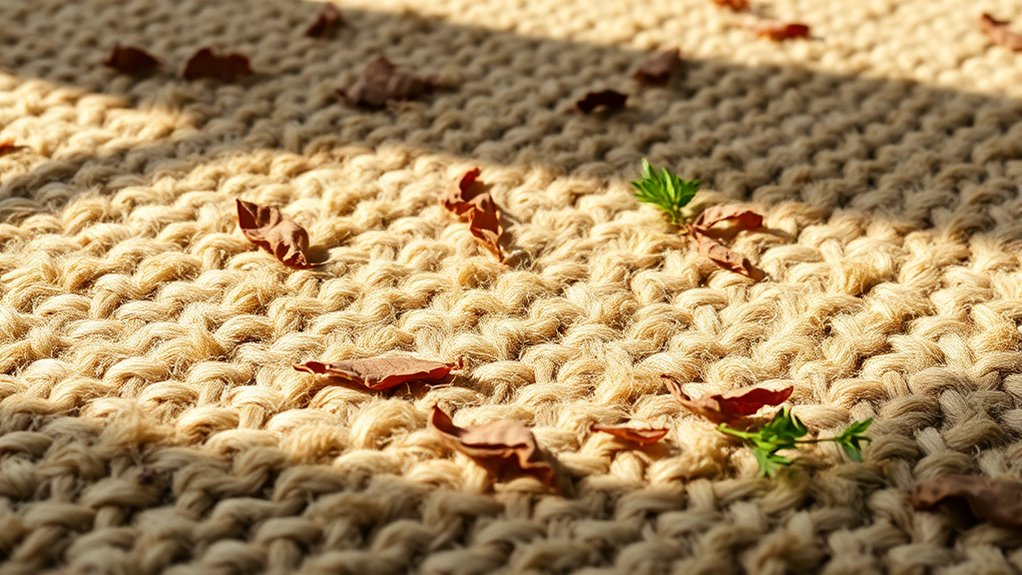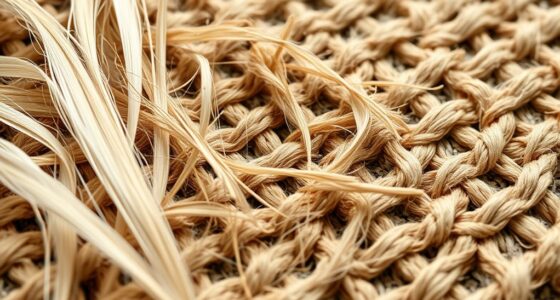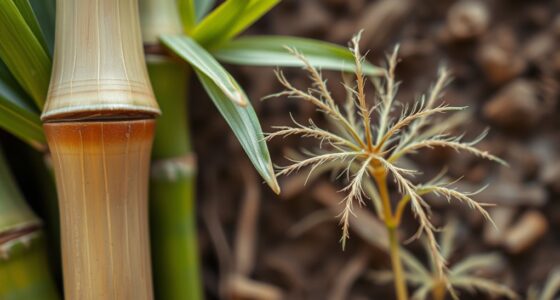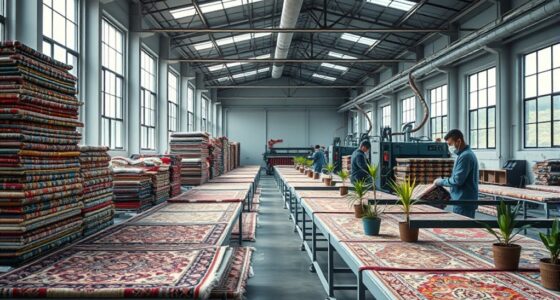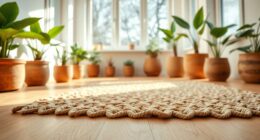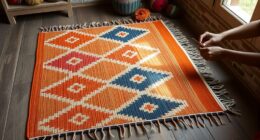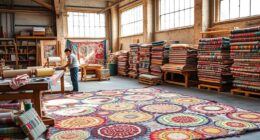Biodegradable rugs are transforming sustainable flooring by using natural fibers like jute, sisal, or cotton that decompose safely in compost or soil, reducing landfill waste and pollution. Unlike synthetic rugs, these eco-friendly options avoid harmful chemicals and are made through practices that minimize environmental impact. They offer durability and style while supporting eco-conscious habits. If you’re curious about how these innovative rugs are shaping a greener future, there’s much more to explore below.
Key Takeaways
- Biodegradable rugs utilize natural fibers like jute, sisal, and cotton, promoting eco-friendly and renewable flooring options.
- Innovative manufacturing methods incorporate biodegradable additives and natural dyes to enhance sustainability.
- These rugs decompose safely in compost or soil, reducing landfill waste and environmental pollution.
- Advances in sustainable production minimize water use, chemical reliance, and carbon footprint during manufacturing.
- Biodegradable rugs support circular economy principles by returning nutrients to the environment after use.

Have you ever wondered what happens to your rug once it’s no longer in use? Many traditional rugs made from synthetic fibers often end up in landfills, taking years to decompose and contributing to environmental pollution. But with the rise of biodegradable rugs, you now have options that are designed to break down naturally, reducing your ecological footprint. These rugs are crafted from materials that decompose safely and efficiently, making them a responsible choice for environmentally conscious consumers.
Biodegradable rugs are typically made from natural fibers like jute, sisal, or cotton, which are renewable and biodegradable by nature. However, some manufacturers also incorporate innovative materials that are both durable and eco-friendly. These may include bio-based polymers or blends of natural fibers with biodegradable additives. The key is that these materials are chosen carefully to ensure they break down in a reasonable time frame after disposal, unlike synthetic fibers such as nylon or polyester, which can persist for decades. Synthetic fibers are widely used because they’re inexpensive and durable, but their environmental impact is significant, especially when they are not recycled or disposed of properly. That’s why many eco-conscious companies focus on eco-friendly manufacturing processes, aiming to minimize waste and reduce reliance on non-renewable resources during production.
Biodegradable rugs use natural fibers and eco-friendly materials that decompose safely, unlike persistent synthetic fibers.
When you select a biodegradable rug, you’re supporting manufacturing practices that prioritize sustainability. Eco-friendly manufacturing methods reduce the use of harmful chemicals and conserve resources, ensuring that the entire lifecycle of your rug aligns with environmental values. These practices often involve using natural dyes, reducing water consumption, and sourcing materials responsibly. This way, you can enjoy a beautiful, functional rug without feeling guilty about its environmental impact.
In addition to being made from eco-friendly materials, biodegradable rugs often feature designs that promote longevity and ease of disposal. Once they reach the end of their lifespan, these rugs naturally decompose when exposed to composting conditions or soil, leaving no harmful residues behind. This contrasts sharply with traditional synthetic rugs, which can linger in landfills for hundreds of years, leaching chemicals into the environment. Choosing a biodegradable rug means you’re actively participating in reducing waste and supporting a circular economy where products are designed to return to the earth instead of polluting it.
Frequently Asked Questions
How Long Do Biodegradable Rugs Typically Last in Use?
Biodegradable rugs typically last around 1 to 5 years, depending on durability considerations and material lifespan. If you choose a rug made from natural fibers like jute or seagrass, expect a shorter lifespan due to their eco-friendly nature. Proper care can extend their use, but ultimately, these rugs are designed to be sustainable and biodegradable, meaning they won’t last as long as synthetic options but offer a greener alternative for your space.
Are Biodegradable Rugs Suitable for Outdoor Environments?
Imagine a rug that breathes with nature—biodegradable rugs are suitable for outdoor environments, thanks to their outdoor durability and weather resistance. They stand up well against rain and sun, making them ideal for patios and gardens. While they may not last as long as synthetic options, their eco-friendly design guarantees you’re kind to the planet while enjoying a stylish, sustainable outdoor space.
What Are the Cost Differences Compared to Traditional Rugs?
You’ll find that biodegradable rugs generally cost more than traditional rugs. A thorough price analysis shows their eco-friendly materials and innovative production methods drive up costs. While initial expenses are higher, you might save money long-term through environmental benefits and durability. Keep in mind, prices vary based on size, design, and brand. Overall, expect a noticeable difference in cost comparison, but consider the sustainability benefits as part of your investment.
Can Biodegradable Rugs Be Recycled After Disposal?
Yes, biodegradable rugs can often be recycled after disposal through specialized recycling processes. These processes focus on material recovery, breaking down the rug’s organic components to reuse in new products. You should check if local recycling centers accept biodegradable materials, as recycling options vary. Proper disposal guarantees the rug’s materials are recovered effectively, reducing waste and supporting environmental sustainability.
Do Biodegradable Rugs Emit Any Harmful Chemicals During Degradation?
Biodegradable rugs generally don’t emit harmful chemicals during degradation, making them safer for indoor air quality. Most are made from natural fibers like jute, sisal, or cotton, which break down without releasing toxic substances. However, if synthetic dyes or adhesives are used, there could be some chemical emissions. To guarantee better indoor air quality, choose rugs with natural, eco-friendly materials and avoid those with synthetic chemicals.
Conclusion
As you step onto these biodegradable rugs, imagine walking on a future where your choices bloom into a greener world. These innovative fibers are like seeds of change, transforming your home into a sanctuary that nurtures the planet. By choosing sustainable flooring, you’re planting hope and weaving a legacy of care with every step. Embrace this eco-friendly revolution—because your home can be both beautiful and a beacon of sustainability, guiding us toward a brighter, greener tomorrow.
